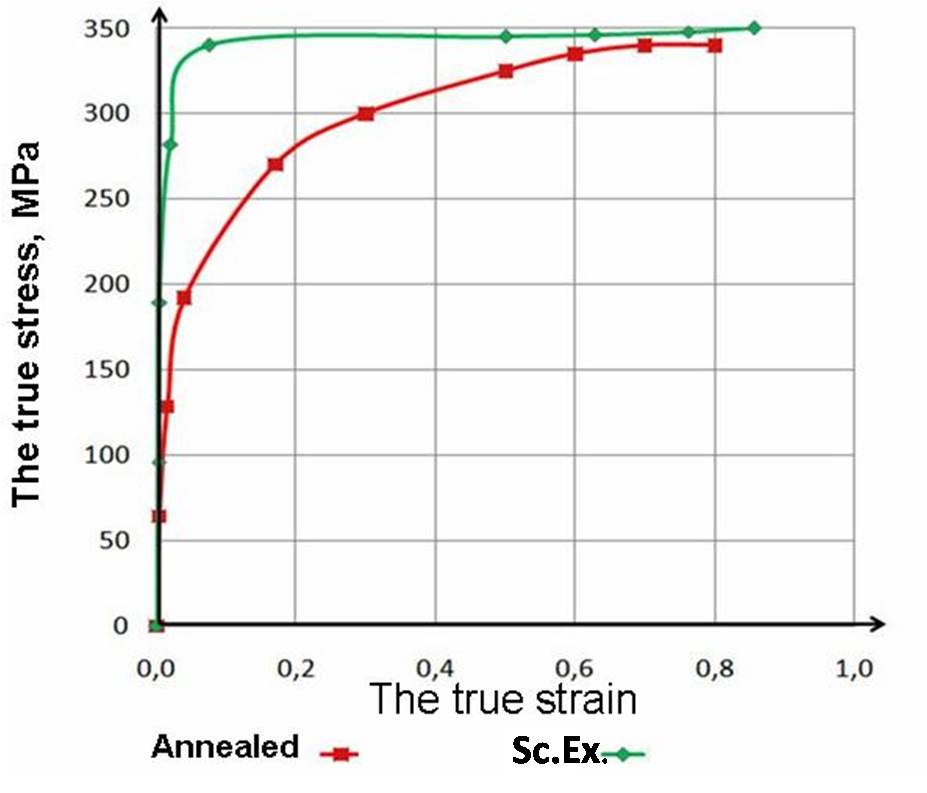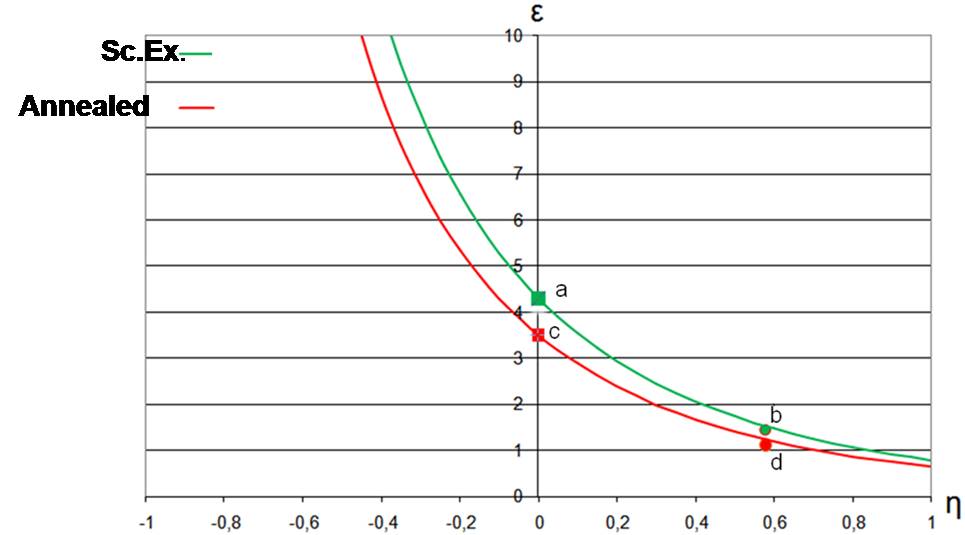Abstract
Содержание
- Introduction
- 1. Relevance of the topic
- 2. The purpose and objectives of the research
- 3.Materialy and research research
- 4.Rezults research
- Conclusion
- References
Introduction
After a small amplitude (0.01-0.05) cyclic deformation observed for metals, and lowering of yield strength increase plasticity[ 4 ]. This phenomenon is used in certain industries, such as in the wire drawing industry. After wire drawing instead of normalizing annealing used rihtovanie wire with a small amplitude cyclic deformation (0.01-0.05). This is done for the partial removal of internal stresses and increasing plasticity wire[8].
In this work,investigate how will change properties of the copper grade M3, if subjected to cyclic deformation at high amplitude (≥0,5) under high pressure (P≥σs) and the equivalent deformation of more than 5. Copper was a screw extrusion (4 runs) then copper was cut into samples that were tested for tensile, compression, torsion and compared to what changes in the properties of copper in comparison with annealed copper, which is also tested for the above listed tests.
1. Relevance of the topic
Application of cyclic deformation small amplitude (0,01-0,05) promotes increasing plasticity metal technology different products. It can be used as a method of increasing the plasticity resource copper production process, thereby enhancing the quality of products and lowering production costs. Also, changes in the properties of copper after cyclic deformation with large amplitude (≥0,5), high pressure (P≥σs) and the equivalent strain of more than 5, hardly investigated. This is a broad area for research.
2. The purpose and objectives of the research
The aim of this work was - study of the effect of cyclic strain on the mechanical properties of copper. Also in the course of work and solved the following problem: the identification of the influence of cyclic deformation of copper with the desired properties
3.Materialy and research
As a test material selected mark M3 copper. This material is well understood and there is a large amount of published data on the properties of copper after various treatments pressure.
Original hot rod diameter 50mm, in order to save material was subjected to forging cross-section 19х29 mm. The resulting material was cut into two-length and made up to the required cross-section 18х28 mm. The material is then subjected to heat treatment in an oven at t = 550 ° C for 1 hour to relieve the residual stresses. At the next stage, one of the annealed copper M3 was cut into three-length, one of which is further subjected to a tensile test, and the second and third torsional compression. The second sample annealed copper subjected to deformation by extrusion screw [ 1 ].
Of the deformed specimens screw extrusion fabricated test specimens in torsion, compression and tension in accordance with GOST 3565-80 "Metals. Test Method for Torsion"[ 5 ], "GOST 8817-82 Metals. Method for testing the draft"[ 6 ] and GOST1497-84" Research Methods in tension."[ 7 ]. From one work piece processed by CEs prepared three samples - torsion, compression and tensile. During machining and electro-cutting is not allowed to heat samples above 100 °C.
The studies were conducted at room temperature using special equipment. The deformation of the torsion performed on experimental complex, developed in the DonFTI NAS of Ukraine[ 2 ] in 2010. The measurement is performed in accordance with GOST 3565-80. Torsion was conducted before the destruction of the samples. The data obtained is plotted σU = σ(ε) . Sample type shown in Figure 1.
Tensile tests were carried out on the hydraulic universal testing machine brand MUP-50, the maximum force of 50 kN. Deformed specimens to failure. The data obtained is plotted σU = σ(ε).
Compression tests were performed on Instron 5569 force 40kN. To avoid distortions in the sample was placed in a compression special tooling. During rainfall to reduce the effect of friction was used copper foil 15х15х0,1 mm, covered with a graphite lubricant oil, which was placed at the ends of the sample, so that the grease is between the test sample and the foil. During plastic deformation of the sample, graphite grease and a copper substrate can almost freely upsetting material, preventing the barrel. Sample height compression is 12 mm - diameter 8 mm. Samples at the end of the test is not destroyed.
4. Results research
Figure 2 shows the test results in torsion.
The graph shows that the material is subjected to pre-extrusion screw has a greater yield strength than the sample annealed copper and destroyed already at the a larger value of the true strain. It will be seen that the sample affected by the screw extrusion is larger plasticity.
The picture 3 shows the results of compression tests.
The samples show a similar behavior as in the torsion test. During the time that when the sediment samples not destroyed.
Next, Figure 4 shows the results of tensile tests
During tensile specimens behave similarly to the samples when tested in torsion and compression, the sample annealed copper has a lower yield stress and destroyed by the greater value of true strain. Also, it will be shown that the sample treated by extrusion has higher ductility relative annealed copper samples.
For the analysis of the plasticity of the samples of copper brand M3 there are graphs the limiting plasticity. The materials are not destroyed during compression - it gave us the opportunity to use a ratio of work G.D. Dely [ 3 ]:
where ε p - the the limit plasticity, η- rigidity index stress.
In Table 1 are shown experimentally determined values of the limiting plasticity in tension and torsion for annealed copper and copper exposed screw extrusion.
| Test | εp, Sc.Ex. | εp, an annealed |
| Tension | 1,5 | 1 |
| Torsion | 4,4 | 3,5 |
Figure 5 shows the diagram the limiting plasticity constructed by formula (1). They also marked points plasticity the limiting experimental values as for the annealed copper and copper subjected to extruding screw in tension and torsion. The points are placed exactly on these charts the limiting Plasticity - it demonstrates the adequacy of (1). The diagrams show that the plasticity of copper exposed large amplitude cyclic strain (≥ 0,5) and under high pressure (P ≥σ s ) is higher than that of annealed copper throughout hardness values range studied stress.
Conclusion
1. Cyclic deformation with a small amplitude (0.01-0.05) reduces yield strength and increases ductility.
2. The cyclic deformation of large amplitude (≥ 0,5) under high pressure (P ≥σs) and the equivalent strain of more than 5 leads to an increase of plasticity and yield strength.
References
- Бейгельзимер Я. Е. Винтовая экструзия – процесс накопления деформации / Бейгельзимер Я. Е., Варюхин В. Н., Орлов Д. В. – Донецк : Фирма ТЕАН, 2003. – 87 с
- Валиев Р. З. Наноструктурные материалы, полученные методом интенсивной пластической деформации / Р. З. Валив, И. В. Александров. – М. : Логос, 2000. –272 c.
- Дель Г.Д. Технологическая механика. – М.: Машиностроение, 1978.-174с..
- Целиков, А.И. Машины и агрегаты металлургических заводов: в 3 т. / А.И.Целиков. – М.: Металлургия, 1981. Том3: Машины и агрегаты для производства и отделки проката. – 576с.
- ГОСТ 3565-80 “Металлы. Метод испытания на кручение”.
- ГОСТ 8817-82 “Металлы. Метод испытания на осадку ”.
- ГОСТ1497-84 “Методы исследований на растяжение”.
- Оборудование для обработки труб, профилей, проволоки. Правильно-рихтовочное оборудование.[Электронный ресукрс]- Режим доступу: http://stanko-lid.ru/...






